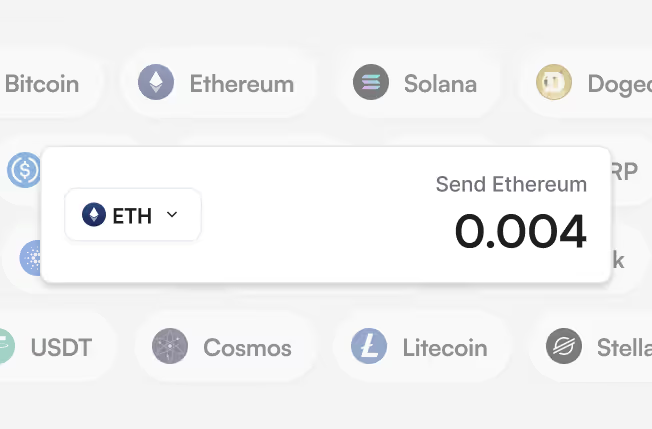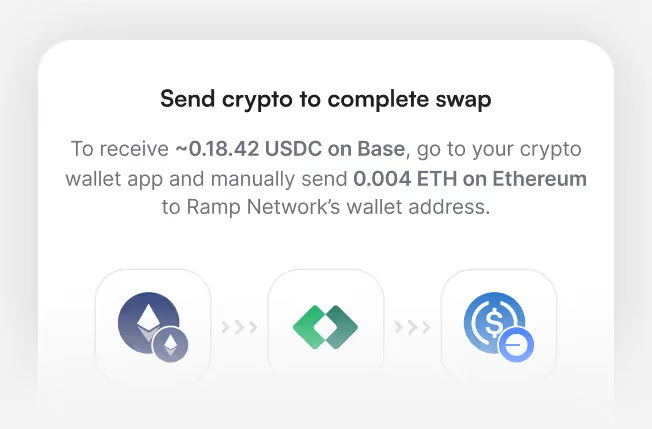


Swap Bitcoin to Ethereum instantly.
Convert Bitcoin (BTC) to Ethereum (ETH) quickly and securely with Ramp Network – no complex bridges or decentralized exchanges needed.


.svg)










Convert Bitcoin (BTC) to Ethereum (ETH) quickly and securely with Ramp Network – no complex bridges or decentralized exchanges needed.


.svg)







Swapping Bitcoin (BTC) for Ethereum (ETH) with Ramp Network is simple and secure. The process is designed to be clear, fast, and user-friendly from start to finish.

1
Choose Bitcoin (BTC) and Ethereum (ETH), enter the amount you’d like to swap, and check the live exchange rate before moving forward.

2
Sign up with your preferred method and confirm your country of residence to proceed.

3
Ramp Network supports both self-custodial wallets such as Ledger or MetaMask and custodial exchange accounts. You stay in control of your funds throughout the process.

4
Transfer the BTC from your wallet. Once the transaction is confirmed on the Bitcoin network, ETH is delivered directly to your selected wallet or exchange account.

Ramp Network supports both self-custodial wallets such as Ledger or MetaMask and custodial exchange accounts. When swapping BTC for ETH, you simply connect your wallet, review the details, and confirm the exchange.






The process is designed to stay simple and transparent. Ramp Network removes unnecessary blockchain complexity, making BTC-to-ETH swaps accessible to both beginners and advanced users.
You stay in full control of your funds. BTC is sent directly from your wallet, and ETH is delivered to the destination wallet or exchange account you choose. Ramp Network never keeps your assets in long-term custody.
Ramp Network operates in key regions including the UK, EU, and US. Supported networks and currencies are displayed clearly during checkout.

Before confirming your BTC-to-ETH exchange, you’ll see all transaction details, including live rates and any applicable fees, so you always know what to expect.
*When compared to transferring via an exchange

Bitcoin has been around long enough to stop feeling like an experiment. Back in 2009, a few developers started testing what sounded impossible, money that didn’t rely on banks or governments.
People began using Bitcoin to send value online, anywhere, without waiting for approvals or trusting a middleman. Every transaction is recorded publicly, and no single company controls it.
There will never be more than 21 million Bitcoins. That’s not marketing, it’s baked into the code. Because of that limit, people often compare it to gold, but digital. Over time, it’s become something more practical: freelancers get paid in BTC, travelers carry it instead of cash, and some investors treat it as a backup plan when traditional systems feel shaky. It’s not hype anymore, it’s just part of how money moves in 2025.
Bitcoin (BTC) is the world’s first cryptocurrency, launched in 2009 by the mysterious creator known as Satoshi Nakamoto. Built on blockchain technology, Bitcoin introduced a new way of transferring value online without the need for banks or intermediaries. Its decentralized nature, combined with a fixed supply of 21 million coins, makes it a unique digital asset often referred to as “digital gold.”
Today, Bitcoin is the most recognized and widely used cryptocurrency worldwide. Millions of people use it for trading, investing, and cross-border payments, while businesses across industries accept Bitcoin payments as a secure and transparent alternative to traditional money. Its popularity continues to grow, supported by increasing adoption from financial institutions, mainstream investors, and even governments exploring Bitcoin regulation.
What makes Bitcoin special is its combination of scarcity, security, and decentralization. Unlike fiat currencies that can be printed endlessly, Bitcoin’s supply is limited, creating long-term value potential. Its blockchain is maintained by thousands of nodes across the globe, ensuring transactions remain transparent and resistant to censorship. For many users, Bitcoin represents more than just an investment — it’s a revolutionary step toward financial freedom and the future of money.
The chart displays an indicative, mid-market exchange rate. Effective exchange rate might be different.

Ethereum came a few years later and changed what a blockchain could actually do. Vitalik Buterin and the early team wanted something programmable, a way to build apps that run on their own, without servers or companies behind them. That idea became smart contracts, and that single feature kicked off a wave of projects we now call Web3.
ETH, the network’s currency, powers all of it. You use it to pay for transactions, stake it to help secure the network, or interact with apps that live entirely on-chain. Ethereum has evolved, too – it moved from energy-heavy mining to a greener proof-of-stake model, cutting its carbon footprint dramatically.
These days, most people using DeFi apps or trading NFTs don’t even realize they’re using Ethereum underneath, and that’s kind of the point. The tech is fading into the background while the ecosystem keeps growing.
Bitcoin (BTC) is the world’s first cryptocurrency, launched in 2009 by the mysterious creator known as Satoshi Nakamoto. Built on blockchain technology, Bitcoin introduced a new way of transferring value online without the need for banks or intermediaries. Its decentralized nature, combined with a fixed supply of 21 million coins, makes it a unique digital asset often referred to as “digital gold.”
Today, Bitcoin is the most recognized and widely used cryptocurrency worldwide. Millions of people use it for trading, investing, and cross-border payments, while businesses across industries accept Bitcoin payments as a secure and transparent alternative to traditional money. Its popularity continues to grow, supported by increasing adoption from financial institutions, mainstream investors, and even governments exploring Bitcoin regulation.
What makes Bitcoin special is its combination of scarcity, security, and decentralization. Unlike fiat currencies that can be printed endlessly, Bitcoin’s supply is limited, creating long-term value potential. Its blockchain is maintained by thousands of nodes across the globe, ensuring transactions remain transparent and resistant to censorship. For many users, Bitcoin represents more than just an investment — it’s a revolutionary step toward financial freedom and the future of money.
The chart displays an indicative, mid-market exchange rate. Effective exchange rate might be different.
Customers like you have traded over $1 billion in crypto with Ramp Network.